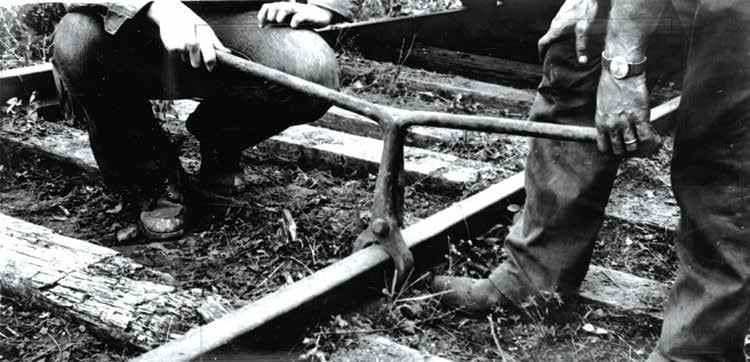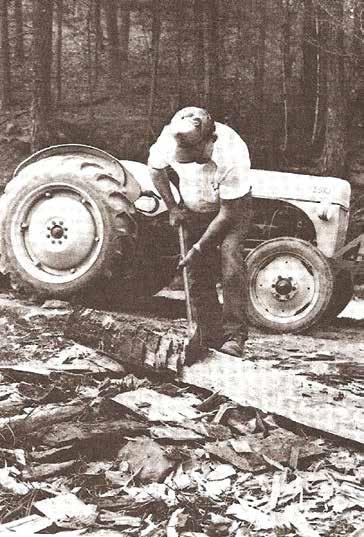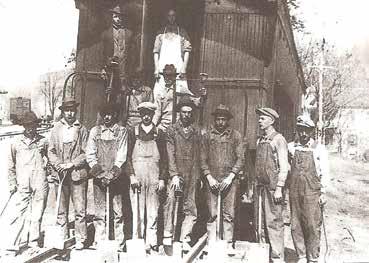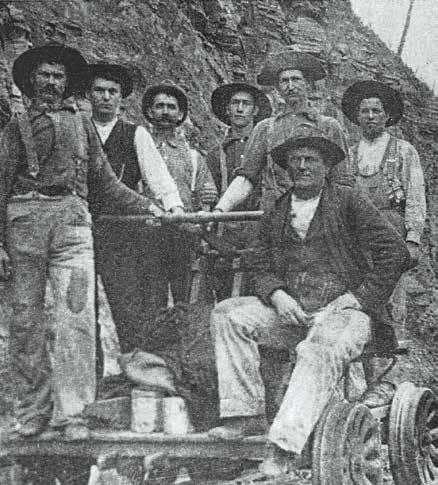
10 minute read
Rabun County Historical Society Working on the Tallulah Falls Railroad
from the Rabun County Historical Society Working on the Tallulah Falls Railroad
Meager Wages, Women Hewing Crossties and Frozen Overalls
By Dick Cinquina
Rabun County was remote and isolated, populated by subsistence farmers scratching out a living on hardscrabble mountain land. The Tallulah Falls Railroad opened Rabun and the surrounding region to the outside world. The TF also brought badly needed jobs. Working on the TF involved backbreaking labor for paltry wages, typically about one dollar per day. But mountain men and women eagerly sought railroad jobs, since meager pay was better than no money at all. Much of the following narrative about railroad jobs and the men and women who did them is drawn from oral histories compiled by the Foxfire Museum and Heritage Center in Mountain City.
Picks, Shovels and Mule-Pulled Scrapers
The TF used some of the roadbed prepared by the defunct Blue Ridge Railroad decades earlier. Preparing miles of new roadbed for tracks was the first work offered by the TF. Carving a route through mountainous terrain was done laboriously with picks, shovels and scrapers pulled by mules. When rock outcroppings were encountered, “cuts” were blasted.
Will Seagle, who worked on the TF from the Georgia state line to Franklin, recalled the time when dynamite used to blast a cut accidentally exploded. “I seed him (one of the workers) a-goin’ up (in the air)…I run and jumped in the river and got him out… he didn’t have a rag nor a shoe on him. Flesh was a-dropping off of him. Boy, he was pitiful. He lived till midnight and then died.” “I drove steel (making holes for the dynamite),” Seagle continued. “There was two of us. There should be a right-hand man and a left-hand man. There was a colored man there, and he was a left-hand man, and the boss asked me, ‘Mr. Seagle, do

Rail tongs allowed workers to pick up and move heavy sections of rail. Photo courtesy of Foxfire Museum and Heritage Center
Dick Cinquina holds graduate degrees in history and journalism, making his work for the Rabun County Historical Society a natural fit for his interests. He is the retired president of Equity Market Partners, a national financial consulting firm he founded in 1981. In addition to writing monthly articles for the Georgia Mountain Laurel, Dick helped produce the Society’s new web site and is involved with the renovation of the group’s museum. After vacationing in this area for many years, he and his wife Anne moved to Rabun County in 2018 form Amelia Island, Florida.
Hewing Crossties from Oak Trees
With the roadbed prepared, the next work involved obtaining the wood crossties onto which the steel rails would be spiked. “A lot of people hewed (chopped crossties out of trees with an ax),” according to Dan Crane. “They had to. That’s the only way they had to make a few dollars to buy groceries with.” After he cut down a tree with his crosscut saw, Roosevelt Burrell would stand on the log “and start busting chips out. Get right up on top of her and go to chopping. Just chop one end to the other, and then turn that around and hit the other side.” Homer Parker recalled, “My daddy could hew ten crossties (a day). Eight was a good, easy day’s work. I could hew six or seven myself, and I was just a boy then, 16 or 17 years old.”
45-55 Cents for First-Class Crossties
Oak was the preferred lumber for crossties, which had to be eight feet, six inches long and seven inches thick with a nineinch face. Dan Crane explained, “The hewed crossties came from the heart of the tree, and they would last longer than the sawed ones that were cut out of any part of the tree, so the railroad would pay more for a hewed one than a sawed one…The railroad paid 45 to 55 cents for a first-class tie and 25 to 45 cents for a second-class tie.” Hewing crossties was not simply work for men. Mary Cabe reminisced, “I’ve cut many a cross tie … Anybody who could hew good could hew one in an hour, after they got it (the tree) sawed down.” Many people, including women, also cut firewood as fuel for the wood burning locomotives used during the early years of the TF. The firewood was stacked at designated places along the side of the tracks. The railroad would inspect the woodpile and pay the cutter.
Driving Spikes
Rails were attached to crossties with spikes. Lawton Brooks said, “I’ve drove many a spike. Now you might think that was easy. You start that (the spike) in an old white oak (crosstie) with an eight-pound hammer, that’s what you drove with. Come over that hammer and hit the spike, you straddling that hot rail, the sun a-boiling down on you. Man, you talk about sweating…I’d rather do anything than spike up track all day. It hurts your old back stooping over all day.” Once the rails were laid and the trains were running, maintaining the railroad was an ongoing challenge. Section crews maintained the roadbed and tracks, while bridge crews repaired the bridges and wooden trestles.
Section Crews and Convicts
Section crews were assigned an eight to 10 mile section of track. Paid one dollar for a 10-hour day, workers were hired from the area near their section so they could live at home. The crew was responsible for replacing crossties and rails and keeping rail joints smooth and level. When crossties were replaced, both sides of the track were jacked up. Occasionally, a worn rail had to be replaced. Each rail was 30 feet long and weighed about 600 pounds. Two men grabbed and lifted the rail with a rail dog. The Hewing crossties for the railroad new rail then had to be “gauged,” meaning rails had to be 56 ½ inches apart, although being off by ½ inch was acceptable. Anything more than that could cause a train derailment. Lawton Brooks recalled the time a landslide destroyed a lengthy section of track. “We (his section crew) had to build the railroad back up. They even sent the convicts to help us that time. They had the durn woods full of convicts…It was three nights, I know, before I went home.”

Maintaining 42 Wooden Trestles
The most spectacular feature of the TF was its 42 enormous, wooden-truss trestles that could carry the weight of a 70-ton train. However, those engineering marvels required extensive, ongoing maintenance. Unlike section crews, bridge crews worked the TF’s entire 58 miles. According to Fred Williams, bridge crews lived in shanty cars. “There we cooked, ate and slept. We had one car to cook and eat in, the other to sleep in. The shanty cars pulled us from one place to another to repair the trestles.”
Carl Rogers remembered that bridge crew workers “would just swing down right under the trestles. They had ropes, and they had a hoist mounted on that flatcar, and they’d secure that flatcar to the rails and let the (replacement) lumber down.
And they would climb those trestles. I don’t mean to compare them to monkeys but they were very agile.”
37 Cents/Hour Was Good Pay
Injuries were not uncommon while repairing trestles. J.B. Stubblefield remembered, “They’d let a piece of timber fall and hit ‘em, or maybe their foot slipped and they fell (into the ravine or stream below). Bridge crews were compensated for the dangers they faced with better pay than section crews. Roy Shope recalled, “When I left section to go to a bridge gang, I was making 20 cents an hour. The bridge gang was paid good money, and I think I went to work there for 37 cents an hour. That was good pay.”

Frozen Overalls Stood By Themselves
TF bridge crew at their shanty car
Lawton Brooks recalled the time an ice jam broke loose and washed out a trestle. To clear the maze of fallen timbers, “You got in that water, stay in there five minutes, get out and stand by the fire five minutes, and jump back in and stay five more minutes. Your legs would get numb, froze.” After going home, he said he “laid down on the bed, and my wife would have to pull my overalls off, and she’d set them against the wall and they’d stand there. After a while, you’d see them go down (as they thawed). Yeah, froze.” The running crew of a TF train consisted of the engineer, fireman, brakeman and flagman. On passenger trains there also would be a conductor and frequently a postmaster responsible for mail service to the communities along the line.
Locomotive Engineers
The only way the engineer could figure the train’s speed was to measure the time traveled between mileposts. The engineers also had “meet orders,” instructing them where and when to expect a train coming in the opposite direction, since the TF was a single-track railroad. Engineer Goldman Kimbrell recalled, “A freight train would have a certain time to be at a certain place… If you were delayed, you had to report it to the agent at the nearest depot.” If the delayed train was not near a station, Kimbrell said, “You could usually flag down an automobile to go to the nearest station. Course, if you broke down or derailed and they was somebody coming behind you, then a flagman had to go back to flag him to keep him from crashing into you.” The fireman was responsible for shoveling coal into the steam engine’s firebox and regulating the water flowing into the boiler. It took four hours to bring the engine up to operating temperature. To bring the engine from cold to operating temperature in less time put “a lot of torture on the boiler.”
Shoveling Tons of Coal
The tender behind the locomotive held five tons of coal. Hoyt Tench, a fireman on the TF, remembered, “On a passenger run, I’d use four tons of coal for a round trip. On the freight run, they’d burn six and eight (tons), depending on what kind of load they had. There’s skill to it. You’ve got to know how to throw your shovel in, spread your coal. If your coal is not good or if you put too much in at one time, then you get the white smoke. Then you’ve got to get your rake and rake it up a little, shake down your grate in order to get a dark, black smoke. That’s when it’s steaming, when you get a black smoke, not a white

FRANKLINNORTH CAROLINA

smoke. I always watched my smokestack.” The tender also held 3,000 gallons of water. According to Dan Ranger, “The difference between a good fireman and a bad fireman is that a good fireman knows when to feed water into the boiler to keep the water level up…and he knows at all times on any portion of the railroad where that water level is supposed to be. That is a trick, a real trick.” Perhaps Lawton Brooks best expressed what it was like to work on the TF. “I had to work 10 hours for a pitiful dollar. Ten cents a hour is all they’d give you. You had to work, too. I mean you worked 10 hours. You worked from the time it got light enough to see ‘till it got so dark you couldn’t see. It was the hardest work you’ve ever done, but I loved it better than any work I’ve done in my life.”
Learn more about our history by becoming a member of the Rabun County Historical Society. Membership and complete information about the Society are available at www. rabunhistory.org. You also can visit us on Facebook. Following completion of an extensive renovation, the Society’s museum at 81 N. Church St. in downtown Clayton is expected to reopen later this Spring. However, the building is open from noon to 3 on Saturdays for people interested in researching county and family histories. The Society is a not-for-profit organization under Section 501(c)(3) of the Internal Revenue Code, making your membership dues and donations fully tax deductible.













